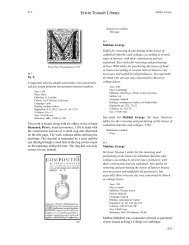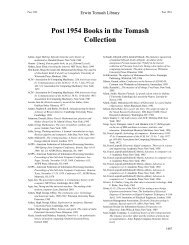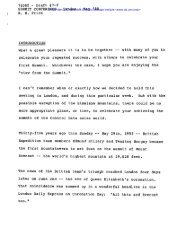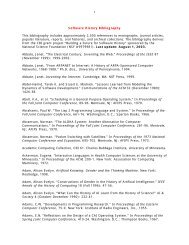B chapter.indd - Charles Babbage Institute - University of Minnesota
B chapter.indd - Charles Babbage Institute - University of Minnesota
B chapter.indd - Charles Babbage Institute - University of Minnesota
Create successful ePaper yourself
Turn your PDF publications into a flip-book with our unique Google optimized e-Paper software.
with fractions rather than integers. The latter sections<br />
contain a discussion <strong>of</strong> elementary algebra, and the final<br />
quarter <strong>of</strong> the book is devoted to tables dealing with<br />
money and similar practical matters.<br />
138<br />
Illustrations available:<br />
Title page (color)<br />
Frontispiece<br />
Roman numerals<br />
Multiplication table<br />
Handwritten gelosia multiplication<br />
Erwin Tomash Library<br />
Beutel, Tobias Bevan, Benjamin<br />
B 145<br />
Frontispiece, B 145<br />
B 146<br />
Bevan, Benjamin (fl.1804–1838)<br />
A practical treatise on the sliding rule. In two parts.<br />
Part the first being an introduction to the use <strong>of</strong> the rule<br />
generally as adapted for calculations that usually occur<br />
to persons in trade. Part the second containing formulæ<br />
for the use <strong>of</strong> surveyors, architects, civil engineers, and<br />
scientific gentlemen.<br />
Year: 1822<br />
Place: London<br />
Publisher: Author<br />
Edition: 1st<br />
Language: English<br />
Binding: original paper boards<br />
Pagination: pp. 101, [7]<br />
Collation: A–F 4 G 2 H–O 4<br />
Size: 227x138 mm<br />
Reference: Tay MP II, #1084<br />
Roman numeral forms, B 145<br />
Multiplication table, B 145<br />
Benjamin Bevan was an engineer and architect/surveyor<br />
who lived in Bushey Heath, England. Little is known<br />
about him, but he notes in the preface that he had spent<br />
eighteen years in very extensive public undertakings and<br />
had taught the use <strong>of</strong> the slide rule to a number <strong>of</strong> young<br />
persons. He developed his new slide rule, with divisions<br />
to three places <strong>of</strong> decimal, some time about 1813. He<br />
was obviously well connected because he was able to use<br />
Jesse Ramsden’s dividing machine for the markings. The<br />
rule was manufactured, beginning about the time <strong>of</strong> this<br />
publication, by William O. Carey (1789–1891), whose<br />
shop was on the Strand in London. Carey advertised the<br />
rule as being for accountants and surveyors.







